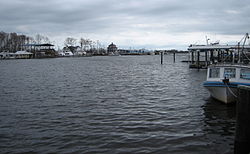geo.wikisort.org - River
The Tchefuncte River (/tʃəˈfʌŋktə/ chə-FUNK-tə) drains into Lake Pontchartrain in Louisiana in the United States. It is about 70.0 miles (112.7 km) long.[1]
| Tchefuncte River | |
|---|---|
 Tchefuncte River as seen at Madisonville | |
| Location | |
| Country | United States |
| State | Louisiana |
| Parishes | Washington, Tangipahoa, St. Tammany |
| Cities | Covington, Madisonville |
| Physical characteristics | |
| Source | |
| • location | Tangipahoa Parish, Louisiana |
| • coordinates | 30°54′22″N 90°20′59″W |
| Mouth | Lake Pontchartrain |
• location | Madisonville, St. Tammany Parish, Louisiana |
• coordinates | 30°22′36″N 90°09′38″W |
| Length | 70 mi (110 km)[1] |
| Basin features | |
| Tributaries | |
| • left | Bogue Falaya |
| GNIS number | 1628339[2] |
Etymology
The name Tchefuncte is believed to derive from the word Hachofakti which is the Choctaw word for the American chinquapin which is a species of chestnut and was used by Native Americans to relieve headaches and fevers.[3]
Tchefuncte culture
The area around the river was inhabited by the hunter-gatherer Tchefuncte culture dating back to 600 BCE.[4] The Native Americans gathered fresh-water clams, fish and crawfish and built shell middens on the river. Their houses were probably temporary circular shelters having a frame of light poles covered with palmetto, thatch, or grass mixed with mud.[5]
Tchefuncte shipyard
During the War of 1812 the Secretary of the Navy William Jones ordered Captain John Shaw to supervise the construction of a shallow-draft Blockship armed with 32 heavy cannons at the shipyard in Madisonville, Louisiana.[6] On December 16, 1814 Major General Andrew Jackson wrote a letter to the Secretary of War John Armstrong Jr. demanding that the ship be completed. When the Battle of New Orleans began the vessel was still moored at the Madisonville Naval shipyard unfinished.
![Madisonville's Tchefuncte River Lighthouse stands resolutely on the Saint Tammany northshore of Lake Pontchartrain. This lighthouse was built in 1837.[7]](http://upload.wikimedia.org/wikipedia/commons/thumb/5/54/Madisonville_lighthouse_2.JPG/300px-Madisonville_lighthouse_2.JPG)
Lighthouse
In 1837, the Tchefuncte River Range Lights was built to guide vessels across Lake Pontchartrain to the mouth of the Tchefuncte River. The lighting apparatus was supplied by Winslow Lewis and consisted of nine lamps with several fourteen-inch reflectors. The lighthouse was damaged sometime during the Civil War and was repaired in 1867. The U.S. Coast Guard later took control over the lighthouse in 1939 and used an electrical automation system to power the lighthouse. Then in 1999 the local town of Madisonville, Louisiana assumed ownership and the Institute of Museum and Library Services issued a grant for restoring the historical property. The lighthouse survived the Hurricane Katrina and Rita and continues to be an important historical location.
Course
The Tchefuncte rises in northeastern Tangipahoa Parish and initially flows southward; the river is used to define part of the eastern boundary of Tangipahoa Parish and parts of the western boundaries of Washington and St. Tammany Parishes before turning southeastward into St. Tammany Parish, where it passes the city of Covington and the town of Madisonville. It collects its largest tributary, the Bogue Falaya, at Covington and flows into Lake Pontchartrain about 2 miles (3.2 km) south of Madisonville, near the lake's northern extremity.

The Tchefuncte has been designated by the government of Louisiana as a "Natural and Scenic River." Fairview-Riverside State Park is located along the river, upstream of Madisonville.
Today
In the 19th century it was an important commercial waterway, where building materials and other products of the North Shore of Lake Pontchartrain were loaded to be shipped across the Lake to New Orleans.
See also
- List of Louisiana rivers
References
- U.S. Geological Survey. National Hydrography Dataset high-resolution flowline data. The National Map, accessed June 20, 2011
- "US Board on Geographic Names". United States Geological Survey. 2007-10-25. Retrieved 2019-08-17.
- Clare D’Artois Leeper (19 October 2012). Louisiana Place Names: Popular, Unusual, and Forgotten Stories of Towns, Cities, Plantations, Bayous, and Even Some Cemeteries. LSU Press. p. 244. ISBN 978-0-8071-4738-2.
- Terry L. Jones. The Louisiana Journey. Gibbs Smith; 2007. ISBN 978-1-4236-2380-9. p. 82–83.
- "Louisiana Prehistory: Poverty Point and Tchefuncte". Louisiana Office of Lt. Governor - Department of Culture, Recreation & Tourism. Retrieved 2020-10-05.
- William S. Dudley. The Naval War of 1812 Vol. 1: 1812: A Documentary History. Government Printing Office; 1985. ISBN 978-0-945274-06-3. p. 663–664.
- Brenda Brown Finnegan, Lighthouse Digest.
External links
Другой контент может иметь иную лицензию. Перед использованием материалов сайта WikiSort.org внимательно изучите правила лицензирования конкретных элементов наполнения сайта.
WikiSort.org - проект по пересортировке и дополнению контента Википедии